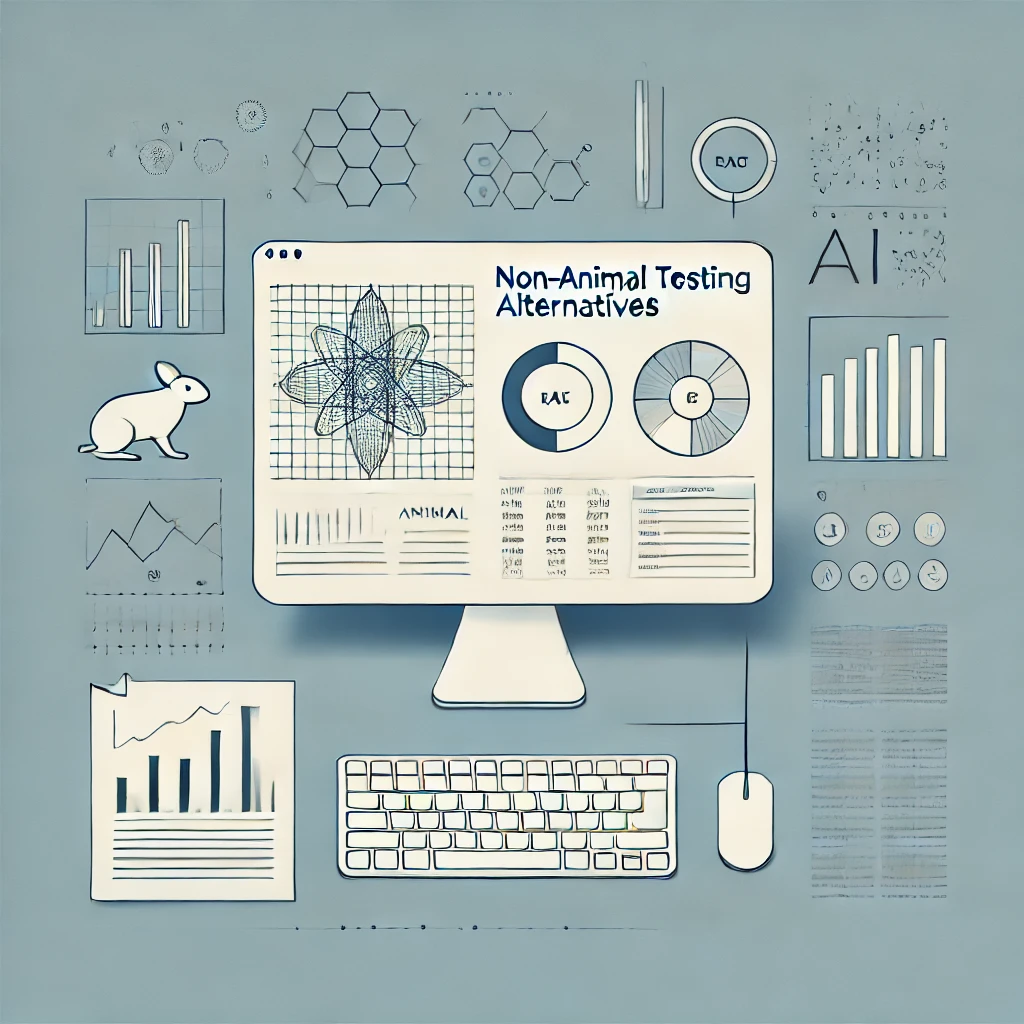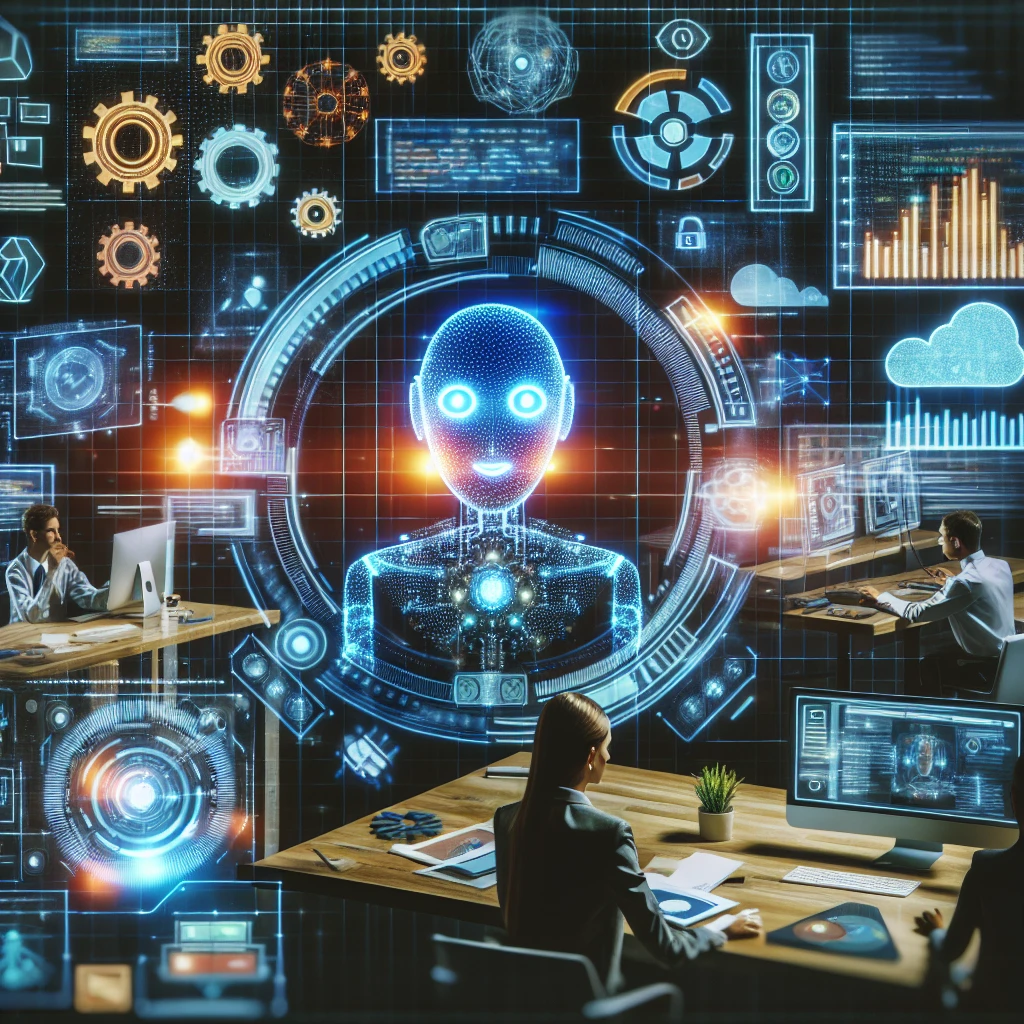The use of animals in scientific testing has long been a controversial issue. However, researchers are now exploring the use of artificial intelligence (AI) to find alternatives to animal testing. One application of AI in this field is using it to analyze existing animal testing data to prevent the need for unnecessary new tests. AI models like ChatGPT can extract and synthesize this data, making it easier for scientists to find and analyze the information they need. AI is also being used to determine the toxicity of new chemicals, which is particularly important given the large number of new compounds entering the market each year.
While AI systems are not perfect, they are proving to be more accurate than animal testing in some cases. One challenge is data bias, where an AI system trained on data from one ethnic group may not be suitable for another group. However, animal testing itself is not always reliable. For example, the arthritis medicine Vioxx passed animal testing but was later withdrawn from sale due to increased risks for humans. On the other hand, some widely used medicines, such as aspirin, would have failed animal tests. AI is being used to create new drugs as well, further demonstrating its potential in this field.
Projects like AnimalGAN and Virtual Second Species are being developed to replace the need for future animal testing. AnimalGAN aims to accurately determine how rats would react to different chemicals, while Virtual Second Species is creating an AI-powered virtual dog based on historic dog test results. However, the major challenge for AI testing is obtaining regulatory approval. While it may take time for full acceptance, efforts should be made to phase out animal testing. The use of animals in testing is considered outdated, and AI has the potential to contribute to a transition away from animal testing in the future. However, it is important to note that animal testing cannot disappear overnight, as it is still necessary in many aspects of research.
In conclusion, AI is being used to find alternatives to animal testing in the field of scientific research. It can analyze existing data, determine the toxicity of new chemicals, and even create new drugs. While AI testing is not without its challenges, it is proving to be more accurate than animal testing in some cases. Projects like AnimalGAN and Virtual Second Species are working towards replacing the need for future animal testing. However, regulatory approval and a phased approach are necessary for the full acceptance and implementation of AI testing.
Original news source: Could AI put an end to animal testing? (BBC)
🎧 Listen:
Slow
Normal
Fast
📖 Vocabulary:
| 1 | controversial | Causing public disagreement or debate |
| 2 | alternatives | Different options or choices available |
| 3 | synthesize | To combine different elements into a coherent whole |
| 4 | toxicity | The degree to which a substance can cause harm |
| 5 | compounds | Substances formed by the combination of two or more elements |
| 6 | bias | A tendency to favor one group or perspective over another |
| 7 | reliable | Consistently good in quality or performance; dependable |
| 8 | withdrawn | Removed from availability or use |
| 9 | regulatory | Related to rules or laws governing a process |
| 10 | phase | To carry out in gradual stages |
| 11 | outdated | No longer in use or considered modern |
| 12 | transition | The process of changing from one state or condition to another |
| 13 | necessary | Required or essential |
| 14 | implementation | The process of putting a decision or plan into effect |
| 15 | approval | Official permission or consent |
Group or Classroom Activities
Warm-up Activities:
– News Summary
Instructions: Have students read the article individually and then summarize the main points in a news article format. They should include the key information and use their own words to create a concise summary.
– Sketch It
Instructions: Divide the class into pairs. One student will describe a scene or concept related to the article while the other student sketches it based on the description. After a set amount of time, they can compare the sketch with the original description and discuss any differences or challenges they encountered.
– Keyword Taboo
Instructions: Write down key vocabulary words from the article on index cards or slips of paper. Divide the class into two teams. One student from each team will take turns drawing a card and trying to describe the word without using the actual word or any variations of it. Their team members must guess the word within a time limit.
– Think-Pair-Share
Instructions: Have students think individually about the topic of animal testing and AI. Then, pair them up to discuss their thoughts and opinions on the subject. After a few minutes, bring the class back together and have a few pairs share their discussions with the whole group.
– Future Predictions
Instructions: Ask students to speculate on the future of animal testing and AI based on the information in the article. They can write down their predictions and then discuss them in small groups. Encourage them to support their predictions with evidence from the article or their own reasoning. After the discussions, have a few groups share their predictions with the whole class.
🤔 Comprehension Questions:
1. How is artificial intelligence (AI) being used to find alternatives to animal testing?
2. What is one application of AI in this field?
3. How are AI models like ChatGPT helping scientists in their research?
4. Why is determining the toxicity of new chemicals important?
5. In what cases is AI proving to be more accurate than animal testing?
6. What is one challenge of using AI in testing?
7. What are AnimalGAN and Virtual Second Species aiming to do?
8. Why is regulatory approval and a phased approach necessary for the acceptance and implementation of AI testing?
Go to answers ⇩
🎧✍️ Listen and Fill in the Gaps:
The use of animals in scientific testing has long been a controversial issue. However, researchers are now exploring the use of artificial (1)______ (AI) to find alternatives to animal testing. One application of AI in this field is using it to analyze existing animal testing data to (2)______ the need for unnecessary new (3)______. AI models like ChatGPT can extract and synthesize this data, making it easier for scientists to find and analyze the information they need. AI is also being used to determine the toxicity of new chemicals, which is particularly important given the large number of new (4)______ entering the market each year.
While AI (5)______ are not perfect, they are proving to be more accurate than animal testing in some cases. One challenge is data bias, where an AI (6)______ trained on data from one (7)______ group may not be suitable for another group. However, animal testing itself is not always reliable. For example, the arthritis medicine Vioxx passed animal testing but was later withdrawn from sale due to increased risks for humans. On the other hand, some widely used medicines, such as aspirin, would have failed animal tests. AI is being used to create new drugs as well, further demonstrating its potential in this (8)______.
Projects like AnimalGAN and Virtual Second Species are being developed to replace the need for future animal testing. AnimalGAN aims to accurately determine how rats would react to different chemicals, while Virtual Second Species is creating an AI-powered virtual dog based on historic dog test (9)______. However, the major challenge for AI testing is obtaining (10)______ approval. While it may take time for full acceptance, efforts should be made to phase out animal testing. The use of animals in testing is considered outdated, and AI has the potential to (11)______ to a transition away from animal testing in the future. However, it is (12)______ to note that animal testing cannot disappear overnight, as it is still (13)______ in many aspects of research.
In conclusion, AI is being used to find (14)______ to animal testing in the field of scientific research. It can analyze existing data, determine the toxicity of new chemicals, and even create new drugs. While AI testing is not without its challenges, it is proving to be more accurate than animal testing in some cases. Projects like AnimalGAN and Virtual (15)______ Species are working towards replacing the need for future animal testing. However, regulatory approval and a phased approach are necessary for the full acceptance and (16)______ of AI testing.
Go to answers ⇩
💬 Discussion Questions:
Students can ask a partner these questions, or discuss them as a group.
1. What is your opinion on the use of animals in scientific testing?
2. How would you feel if AI technology completely replaced animal testing in the future?
3. Do you think AI testing is a more ethical alternative to animal testing? Why or why not?
4. Have you ever heard of any cases where animal testing has led to inaccurate results? Can you share any examples?
5. Do you think it is possible for AI systems to eliminate data bias in scientific testing? Why or why not?
6. How do you think the development of AI testing will impact the pharmaceutical industry?
7. Do you think the use of AI in scientific testing will lead to faster and more efficient drug development? Why or why not?
8. What are some potential challenges or drawbacks of using AI in scientific testing?
9. How do you think the general public will react to the idea of AI testing replacing animal testing?
10. Have you ever had any personal experiences or encounters with animal testing? How did it make you feel?
11. What are some potential benefits of using AI to analyze existing animal testing data?
12. Do you think there are any areas of scientific research where animal testing is still necessary? Why or why not?
13. How do you think the development of AI testing will impact the welfare of animals used in scientific research?
14. What are some potential ethical concerns surrounding the use of AI in scientific testing?
15. Do you believe that AI testing has the potential to completely eliminate the need for animal testing in the future? Why or why not?
Individual Activities
📖💭 Vocabulary Meanings:
Match each word to its meaning.
Words:
1. controversial
2. alternatives
3. synthesize
4. toxicity
5. compounds
6. bias
7. reliable
8. withdrawn
9. regulatory
10. phase
11. outdated
12. transition
13. necessary
14. implementation
15. approval
Meanings:
(A) The process of changing from one state or condition to another
(B) The degree to which a substance can cause harm
(C) Related to rules or laws governing a process
(D) Consistently good in quality or performance; dependable
(E) A tendency to favor one group or perspective over another
(F) Required or essential
(G) To carry out in gradual stages
(H) Different options or choices available
(I) Causing public disagreement or debate
(J) No longer in use or considered modern
(K) Substances formed by the combination of two or more elements
(L) To combine different elements into a coherent whole
(M) Removed from availability or use
(N) The process of putting a decision or plan into effect
(O) Official permission or consent
Go to answers ⇩
🔡 Multiple Choice Questions:
1. What is one application of AI in finding alternatives to animal testing?
(a) Analyzing existing animal testing data
(b) Conducting new animal tests
(c) Training AI systems on data from different ethnic groups
(d) Withdrawing medicines from sale
2. Why is determining the toxicity of new chemicals important?
(a) Because AI systems are not perfect
(b) Because a large number of new compounds enter the market each year
(c) Because animal testing is always reliable
(d) Because AI cannot create new drugs
3. How does AI testing compare to animal testing in terms of accuracy?
(a) AI testing is always more accurate
(b) Animal testing is always more accurate
(c) AI testing is never accurate
(d) AI testing is more accurate in some cases
4. What is one challenge of AI testing?
(a) Obtaining regulatory approval
(b) Analyzing existing data
(c) Data bias
(d) Phasing out animal testing
5. What is the goal of the AnimalGAN project?
(a) To create an AI-powered virtual dog
(b) To accurately determine how rats would react to different chemicals
(c) To analyze existing animal testing data
(d) To withdraw medicines from sale
6. Why is regulatory approval necessary for AI testing?
(a) Because AI testing is always accurate
(b) Because AI testing can replace animal testing overnight
(c) Because animal testing is considered outdated
(d) Because AI testing is a new approach that needs to be accepted and implemented
7. What is the main message of the article?
(a) AI is being used to find alternatives to animal testing
(b) Animal testing is always reliable
(c) AI testing is without challenges
(d) Animal testing should continue indefinitely
8. What is the conclusion of the article?
(a) AI testing is not accurate
(b) Animal testing is necessary in all aspects of research
(c) AI testing should not be accepted or implemented
(d) AI has the potential to contribute to a transition away from animal testing
Go to answers ⇩
🕵️ True or False Questions:
1. AI is being used to determine the toxicity of new chemicals, which is important given the large number of new compounds entering the market each year.
2. AI models like ChatGPT can extract and synthesize data, making it easier for scientists to find and analyze information.
3. AI cannot analyze existing animal testing data to prevent the need for unnecessary new tests.
4. Animal testing itself is always reliable, as evidenced by the case of the arthritis medicine Vioxx.
5. Researchers are exploring the use of artificial intelligence (AI) to find alternatives to animal testing.
6. AI systems are proving to be more accurate than animal testing in some cases.
7. AI is not being used to create new drugs, showcasing its limitations in the field of scientific research.
8. Projects like AnimalGAN and Virtual Second Species are not being developed to replace the need for future animal testing.
Go to answers ⇩
📝 Write a Summary:
Write a summary of this news article in two sentences.
Check your writing now with the best free AI for English writing!
Writing Questions:
Answer the following questions. Write as much as you can for each answer.
Check your answers with our free English writing assistant!
1. How is artificial intelligence (AI) being used to find alternatives to animal testing?
2. What is one application of AI in the field of animal testing?
3. What are some challenges associated with using AI in testing?
4. What are AnimalGAN and Virtual Second Species, and how do they aim to replace animal testing?
5. What is necessary for the full acceptance and implementation of AI testing in place of animal testing?
✅ Answers
🤔✅ Comprehension Question Answers:
1. How is artificial intelligence (AI) being used to find alternatives to animal testing?
– AI is being used to analyze existing animal testing data and prevent the need for unnecessary new tests. It is also used to determine the toxicity of new chemicals and create new drugs.
2. What is one application of AI in this field?
– One application of AI in this field is using it to analyze existing animal testing data.
3. How are AI models like ChatGPT helping scientists in their research?
– AI models like ChatGPT can extract and synthesize data, making it easier for scientists to find and analyze the information they need.
4. Why is determining the toxicity of new chemicals important?
– Determining the toxicity of new chemicals is important because there are a large number of new compounds entering the market each year, and it is crucial to assess their potential risks.
5. In what cases is AI proving to be more accurate than animal testing?
– AI is proving to be more accurate than animal testing in some cases, such as identifying the toxicity of new chemicals.
6. What is one challenge of using AI in testing?
– One challenge of using AI in testing is data bias, where an AI system trained on data from one ethnic group may not be suitable for another group.
7. What are AnimalGAN and Virtual Second Species aiming to do?
– AnimalGAN aims to accurately determine how rats would react to different chemicals, while Virtual Second Species is creating an AI-powered virtual dog based on historic dog test results.
8. Why is regulatory approval and a phased approach necessary for the acceptance and implementation of AI testing?
– Regulatory approval and a phased approach are necessary for the acceptance and implementation of AI testing to ensure its safety, effectiveness, and ethical considerations.
Go back to questions ⇧
🎧✍️✅ Listen and Fill in the Gaps Answers:
(1) intelligence
(2) prevent
(3) tests
(4) compounds
(5) systems
(6) system
(7) ethnic
(8) field
(9) results
(10) regulatory
(11) contribute
(12) important
(13) necessary
(14) alternatives
(15) Second
(16) implementation
Go back to questions ⇧
📖💭✅ Vocabulary Meanings Answers:
1. controversial
Answer: (I) Causing public disagreement or debate
2. alternatives
Answer: (H) Different options or choices available
3. synthesize
Answer: (L) To combine different elements into a coherent whole
4. toxicity
Answer: (B) The degree to which a substance can cause harm
5. compounds
Answer: (K) Substances formed by the combination of two or more elements
6. bias
Answer: (E) A tendency to favor one group or perspective over another
7. reliable
Answer: (D) Consistently good in quality or performance; dependable
8. withdrawn
Answer: (M) Removed from availability or use
9. regulatory
Answer: (C) Related to rules or laws governing a process
10. phase
Answer: (G) To carry out in gradual stages
11. outdated
Answer: (J) No longer in use or considered modern
12. transition
Answer: (A) The process of changing from one state or condition to another
13. necessary
Answer: (F) Required or essential
14. implementation
Answer: (N) The process of putting a decision or plan into effect
15. approval
Answer: (O) Official permission or consent
Go back to questions ⇧
🔡✅ Multiple Choice Answers:
1. What is one application of AI in finding alternatives to animal testing?
Answer: (a) Analyzing existing animal testing data
2. Why is determining the toxicity of new chemicals important?
Answer: (b) Because a large number of new compounds enter the market each year
3. How does AI testing compare to animal testing in terms of accuracy?
Answer: (d) AI testing is more accurate in some cases
4. What is one challenge of AI testing?
Answer: (c) Data bias
5. What is the goal of the AnimalGAN project?
Answer: (b) To accurately determine how rats would react to different chemicals
6. Why is regulatory approval necessary for AI testing?
Answer: (c) Because animal testing is considered outdated
7. What is the main message of the article?
Answer: (a) AI is being used to find alternatives to animal testing
8. What is the conclusion of the article?
Answer: (d) AI has the potential to contribute to a transition away from animal testing
Go back to questions ⇧
🕵️✅ True or False Answers:
1. AI is being used to determine the toxicity of new chemicals, which is important given the large number of new compounds entering the market each year. (Answer: True)
2. AI models like ChatGPT can extract and synthesize data, making it easier for scientists to find and analyze information. (Answer: True)
3. AI cannot analyze existing animal testing data to prevent the need for unnecessary new tests. (Answer: False)
4. Animal testing itself is always reliable, as evidenced by the case of the arthritis medicine Vioxx. (Answer: False)
5. Researchers are exploring the use of artificial intelligence (AI) to find alternatives to animal testing. (Answer: True)
6. AI systems are proving to be more accurate than animal testing in some cases. (Answer: True)
7. AI is not being used to create new drugs, showcasing its limitations in the field of scientific research. (Answer: False)
8. Projects like AnimalGAN and Virtual Second Species are not being developed to replace the need for future animal testing. (Answer: False)
Go back to questions ⇧













